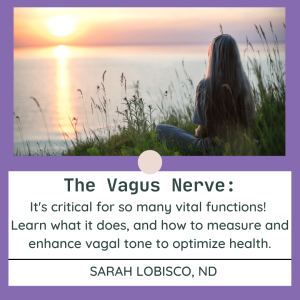
Have you heard of the vagus nerve?
This “vagrant,” or wondering nerve, expands from the brainstem in the medulla oblongata and has many branches throughout the body, mostly in the chest and abdomen.
The vagus nerve is one of the most complicated of the twelve cranial nerves. It plays a critical role in regulating many vital organs. Without a properly functioning vagus nerve your digestion, respiration, heart rate, emotions, and overall health can suffer. Furthermore, it helps enhance the calming response of our nervous system, something many are lacking in today’s world.
Perhaps this is why optimizing vagal nerve function has become so popular in integrative medicine.
In my latest post and video, I review:
- what the vagus nerve is
- what the vagus nerve does
- the functions of the vagus nerves
- signs of vagal dysfunction
- vagal response triggers
- measuring your vagal tone using heart rate variability (HRV)
- ways to balance your vagal tone using holistic practices, lifestyle practices, and nutrition
Click here to learn more about the vagus nerve and how to keep it in optimal shape.
In a future post, we’ll discuss how the vagus nerve links to a new way of dealing with PTSD (post-traumatic stress disorder) based on the polyvagal theory.
I’ll also touch on how essential oils can support this therapeutic application.
Naturopathic Medicine and Holistic Resources for Hormone, Digestive, and Mood Support

- Stay Connected! Sign-up for my free weekly newsletter.
- Free resources and more education on essential oils and mind-body wellness are available to you here.
- Tools for coping with isolation and separation.
- Learn about my community membership program that provides full access to my essential oils database, essential oils course, Q&As, and exclusive content.
Disclaimer: This material is for information purposes only and is not intended to diagnose, treat, or prescribe for any illness. You should check with your doctor regarding implementing any new strategies into your wellness regime. These statements have not been evaluated by the FDA.
This information is applicable ONLY for therapeutic quality essential oils. This information DOES NOT apply to essential oils that have not been tested for purity and standardized constituents. There is no quality control in the United States, and oils labeled as “100% pure” need only to contain 5% of the actual oil. The rest of the bottle can be filled with fillers and sometimes toxic ingredients that can irritate the skin. The studies are not based solely on a specific brand of an essential oil, unless stated. Please read the full study for more information.



